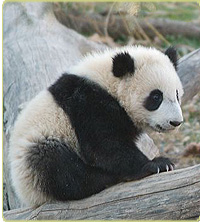|
Giant Pandas by Shelon and Adam CLASSIFICATION GENERAL INFO SPECIAL FEATURES HABITAT DIET REPRODUCTION BODY SYSTEMS HUMAN IMPACT WEBLINKS SOURCES
| ||||

http://nationalzoo.si.edu/Animals/GiantPandas/ Kingdom: Anamalia Giant Panda's reproduce using sexual reproduction.
They are separate sexes and they fertilize internally. Giant Panda's give
birth to live babies and they live alone and take good care of their
young. They usually have 2 cubs but usually only one survives. Giant
Panda's have many different mates during their lifetime. |
GENERAL
INFO:
The Giant Panda are vertebrate deuterstomes. They have a true coelom and an closed circulatory system. Giant panda's have an endoskeleton and are warm blooded mammals. The Giant Panda migrates to lower altitudes during the winter for warmer temperatures. Pandas have black and white markings. The legs, shoulders, ears and oval patches around the eyes are black, and the rest of the coat is white. Giant Pandas weigh an average of 200 to 300 pounds and reach six feet in length. They have no special features. There are very few giant panda's left in the wild due to it's declining territory. The Giant Panda are not beneficial to the human race because scientists have not found any of the Panda's body parts useful in modern day medicines or anything else.
http://academic.scranton.edu/student/LAZAROV2/Food.html BODY SYSTEMS The panda's circulatory system is a closed system, just like humans.
|
HABITAT:
Giant Pandas are only found in dense bamboo mountains in Central China. These mountains are covered with heavy clouds with heavy rains or dense mist throughout the year. A giant panda's home territory will range from 3.8 to 6.5 square kilometers. These mammals do not live in South Dakota.
http://nationalzoo.si.edu/Animals/GiantPandas/ DIET: The Giant Panda is an endangered species. They have
been hunted by humans for thousands of years. Panda pelts can bring two to
three times the average annual income of a rural Chinese peasant in some
Asian markets. There territory has also been declining which is the giant
panda's source of bamboo. Humans cut down trees where the panda lives.
Poaching was considered a serious problem in the past, but is no longer a
major problem. http://nationalzoo.si.edu/Animals/GiantPandas/ http://www.sandiegozoo.org/animalbytes/t-giant_panda.html
| ||

